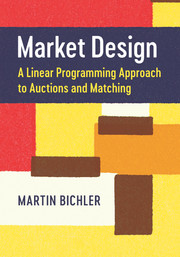2 - Game-Theoretical Basics
from Part I - Microeconomic Fundamentals
Published online by Cambridge University Press: 08 December 2017
Summary
Part I (Microeconomic Fundamentals) of this book provides a succinct introduction to methods and models from microeconomics. In this chapter we introduce and define basic concepts and terminology from game theory will be used throughout the rest of the book. Game theory is the mathematical study of interactions among independent selfinterested agents or players in a game.We limit ourselves to non-cooperative game theory and refer the interested reader to more extensive treatments such as Osborne (2004) or Shoham and Leyton-Brown (2009), whose notation we share. Non-cooperative game theory focuses on situations where self-interested agents have conflicting goals. This chapter will introduce different types of games and central solution concepts, i.e., methods to predict the outcomes of a game played by rational agents. In some parts of the book we will also draw on cooperative game theory, which focuses on predicting which coalitions will form among a group of players, the joint actions that groups take, and the resulting collective payoffs. A cooperative game is a game with competition between groups of players or coalitions. However, we introduce the respective concepts later where needed, in order to keep the chapter concise.
Normal-Form Games
Let us start with a basic type of game description. In normal-form games, players’ actions are simultaneous. In other types of games, called extensive-form games, actions take place sequentially.
Definition 2.1.1 (Normal-form games) A finite normal-form game with n players can be described as a tuple (I, A, u).
• I is a finite set of n players indexed by i.
• A = A1 ×…×An, where Ai is a finite set of actions available to player i. A vector a = (a1, …, an) ∈ A is referred to as an action profile.
• u = (u1,… , un), where ui : A ↦ R is a payoff or utility function for player i.
In definition 2.1.1, finite means that there is a finite set of players and each has a finite set of strategies. Typically, a utility function maps the set of outcomes of a game to a real-valued utility or payoff. Here, the actions possible for an agent also describe the outcomes, which is why we use A in the description of a normal-form game.
- Type
- Chapter
- Information
- Market DesignA Linear Programming Approach to Auctions and Matching, pp. 11 - 29Publisher: Cambridge University PressPrint publication year: 2017



